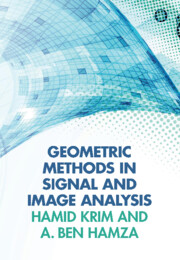6 - Computational algebraic topology
Published online by Cambridge University Press: 05 July 2015
Summary
Data analysis arises in numerous applications, and the solution to many tasks hinges upon the proximal structure in the data as is often encountered in graph-theoretic problems, or upon a model which itself is captured by the topological structure of the data. Thus far, we have discussed extensively the extent to which geometry could shed light on a given data analysis problem. In particular, the notion of metrics and their preservation under transformation is central to any information extraction and exploitation. It is well known, for instance, that the rigid transformation group preserves all distances between points, which can in turn be used in furthering the analysis. It may, for instance, be useful in comparing two objects which are indistinguishable up to a rotation. Topology, on the other hand, heeding no attention to metrics, and as further discussed below, keys on the characteristic features which remain invariant under a fairly large class of transformations. This is specifically the case for homomorphisms acting on objects, while incurring no tearing and/or no gluing of any associated points.
Intuitively, topology of an object describes its coarse features, or in other words its “shape” at a macro scale. Typical questions answered by topology about an object include: Is the object one connected piece? Does it have a hole? Does it have a void? The last notions, with a little thought, extend to any dimension higher than three [131].
A simple illustration of a topological characterization via a homeomorphic property is shown in Figure 6.1 (left) of a surface sheet with a hole which is preserved by a stretching transformation as shown in Figure 6.1 (right). Such a property may also be used to topologically compare two distinct objects. On that basis, the letter “M” is topologically different from “B” but equivalent (or homeomorphic) to “N”. It may indeed be seen that “M” may be continuously modified to “N” through a continuous shortening of the right straight edge and down the wedge to the cusp. A subsequent vertical appropriate lengthening from the cusp yields the “N”.
Information
- Type
- Chapter
- Information
- Geometric Methods in Signal and Image Analysis , pp. 238 - 273Publisher: Cambridge University PressPrint publication year: 2015
